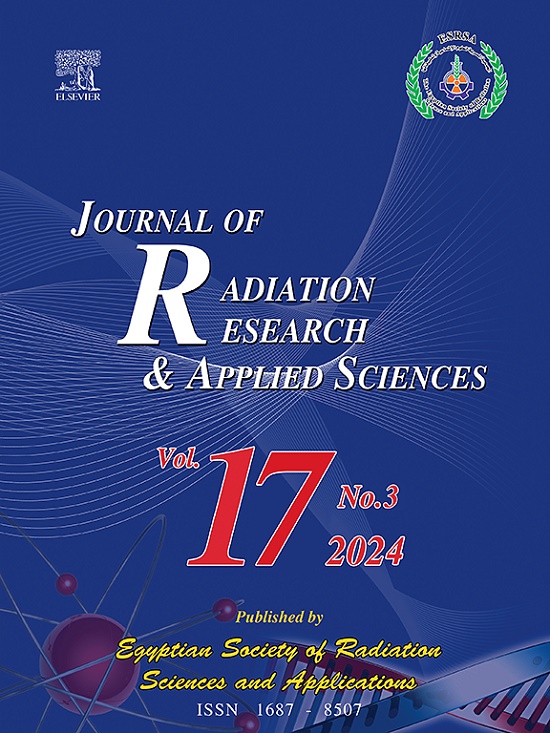Photon attenuation, dose rate and buildup factors of porous glasses containing GeO2
IF 2.5
4区 综合性期刊
Q2 MULTIDISCIPLINARY SCIENCES
Journal of Radiation Research and Applied Sciences
Pub Date : 2025-06-10
DOI:10.1016/j.jrras.2025.101659
引用次数: 0
Abstract
In this present work, SiO2–GeO2–Na2O–B2O3 (SiGeNaBx) glass compositions containing varying additions of GeO2 (22, 33, 44, and 55 mol. %) coded as SiGeNaB1, SiGeNaB2, SiGeNaB3, and SiGeNaB4, respectively, were reported. The effects of variation of GeO2 on the radiation protective properties of the developed porous glasses were then analyzed. The elemental composition showed the glasses contain elements of B (boron), O (oxygen), Si (silicon), germanium (Ge), and Na (sodium), with an increased weight percent of Ge, establishing the formulated glasses. Both mass attenuation coefficient (MAC) and mass energy-absorption coefficient (MEAC) increased with increased GeO2 content, respectively, with SiGeNaB4 exhibiting higher MAC and MEAC values of 42.61 and 29.32 cm2g-1, respectively, but with increased radiation intensity () lower energies. Both effective atomic number (Zeff) and electron density (Neff) also increased with increased GeO2 additions at lower energies (0.015–0.1 MeV). The gamma dose rate decreased with increased thickness of glass samples for all the compositions, while SiGeNaB4 exhibited a lower dose rate, suggesting better shielding performance. Sample SiGeNaB4 also displayed a lower exposure build factor (EBF) at lower energy levels. However, in comparison to other radiation shielding glasses, the developed glasses exhibited promising properties, establishing their potential as radiation shielding materials at low photon energy.
含GeO2多孔玻璃的光子衰减、剂量率及累积因子
本文报道了含有不同添加量的GeO2(22、33、44和55 mol. %)的sio2 - GeO2 - na20 - b2o3 (SiGeNaBx)玻璃组合物,分别编码为SiGeNaB1、SiGeNaB2、SiGeNaB3和SiGeNaB4。分析了GeO2含量的变化对制备的多孔玻璃防辐射性能的影响。元素组成表明,玻璃含有B(硼)、O(氧)、Si(硅)、锗(Ge)和Na(钠)等元素,其中Ge的质量百分比增加,形成了配方玻璃。质量衰减系数(MAC)和质量能量吸收系数(MEAC)分别随着GeO2含量的增加而增加,其中SiGeNaB4的MAC和MEAC值分别为42.61和29.32 cm2g-1,但随着辐射强度的增加能量降低(Γ)。在较低能量(0.015-0.1 MeV)下,有效原子序数(Zeff)和电子密度(Neff)也随着GeO2添加量的增加而增加。所有成分的γ剂量率随玻璃样品厚度的增加而降低,而SiGeNaB4的剂量率较低,表明屏蔽性能较好。样品SiGeNaB4在较低能级下也显示出较低的暴露构建因子(EBF)。然而,与其他辐射屏蔽玻璃相比,所研制的玻璃表现出良好的性能,确立了其作为低光子能量辐射屏蔽材料的潜力。
本文章由计算机程序翻译,如有差异,请以英文原文为准。
求助全文
约1分钟内获得全文
求助全文
来源期刊

Journal of Radiation Research and Applied Sciences
MULTIDISCIPLINARY SCIENCES-
自引率
5.90%
发文量
130
审稿时长
16 weeks
期刊介绍:
Journal of Radiation Research and Applied Sciences provides a high quality medium for the publication of substantial, original and scientific and technological papers on the development and applications of nuclear, radiation and isotopes in biology, medicine, drugs, biochemistry, microbiology, agriculture, entomology, food technology, chemistry, physics, solid states, engineering, environmental and applied sciences.
 求助内容:
求助内容: 应助结果提醒方式:
应助结果提醒方式:


